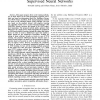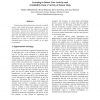200 search results - page 8 / 40 » Margin based Active Learning for LVQ Networks |
AI
2009
Springer
14 years 2 months ago
2009
Springer
Many complex, real world phenomena are difficult to study directly using controlled experiments. Instead, the use of computer simulations has become commonplace as a feasible alte...
TNN
2010
13 years 2 months ago
2010
This paper proposes three novel training methods, two of them based on the back-propagation approach and a third one based on information theory for Multilayer Perceptron (MLP) bin...
PERCOM
2004
ACM
14 years 7 months ago
2004
ACM
Using a networked infrastructure of easily available sensors and context-processing components, we are developing applications for the support of workplace interactions. Notions o...
IROS
2008
IEEE
14 years 2 months ago
2008
IEEE
— This paper presents a method to autonomously extract object features that describe their dynamics from active sensing experiences. The model is composed of a dynamics learning ...
ECTEL
2009
Springer
14 years 2 months ago
2009
Springer
While reading documents, people commonly make annotations: they underline or highlight text and write comments in the margin. Making annotations during reading activities has been ...


